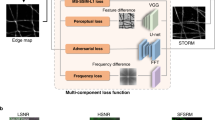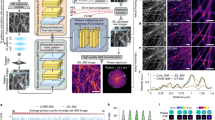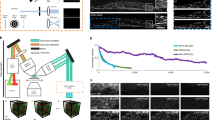Abstract
Single-molecule localization microscopy (SMLM) has revolutionized biological imaging, improving the spatial resolution of traditional microscopes by an order of magnitude. However, SMLM techniques require long acquisition times, typically a few minutes, to yield a single super-resolved image, because they depend on accumulation of many localizations over thousands of recorded frames. Hence, the capability of SMLM to observe dynamics at high temporal resolution has always been limited. In this work, we present DBlink, a deep-learning-based method for super spatiotemporal resolution reconstruction from SMLM data. The input to DBlink is a recorded video of SMLM data and the output is a super spatiotemporal resolution video reconstruction. We use a convolutional neural network combined with a bidirectional long short-term memory network architecture, designed for capturing long-term dependencies between different input frames. We demonstrate DBlink performance on simulated filaments and mitochondria-like structures, on experimental SMLM data under controlled motion conditions and on live-cell dynamic SMLM. DBlink’s spatiotemporal interpolation constitutes an important advance in super-resolution imaging of dynamic processes in live cells.
This is a preview of subscription content, access via your institution
Access options
Access Nature and 54 other Nature Portfolio journals
Get Nature+, our best-value online-access subscription
$29.99 / 30 days
cancel any time
Subscribe to this journal
Receive 12 print issues and online access
$259.00 per year
only $21.58 per issue
Buy this article
- Purchase on Springer Link
- Instant access to full article PDF
Prices may be subject to local taxes which are calculated during checkout






Similar content being viewed by others
Data availability
The datasets analyzed during the current study are available from the corresponding author upon request. The datasets generated during this study are available online: https://doi.org/10.5281/zenodo.7023414.
Code availability
The code is available online at https://github.com/alonsaguy/DBlink.
References
Hell, S. W. & Wichmann, J. Breaking the diffraction resolution limit by stimulated-emission—stimulated-emission-depletion fluorescence microscopy. Opt. Lett. 19, 780–782 (1994).
Gustafsson, M. G. L. Surpassing the lateral resolution limit by a factor of two using structured illumination microscopy. J. Microsc. 198, 82–87 (2000).
Sauer, M. & Heilemann, M. Single-molecule localization microscopy in eukaryotes. Chem. Rev. 117, 7478–7509 (2017).
Betzig, E. et al. Imaging intracellular fluorescent proteins at nanometer resolution. Science 313, 1642–1645 (2006).
Rust, M. J., Bates, M. & Zhuang, X. Sub-diffraction-limit imaging by stochastic optical reconstruction microscopy (STORM). Nat. Methods 3, 793–795 (2006).
Sharonov, A. & Hochstrasser, R. Wide-field subdiffraction imaging by accumulated binding of diffusing probes. Proc. Natl Acad. Sci. USA 103, 18911–18916 (2006).
Schnitzbauer, J., Strauss, M. T., Schlichthaerle, T., Schueder, F. & Jungmann, R. Super-resolution microscopy with DNA-PAINT. Nat. Protoc. 12, 1198–1228 (2017).
Ouyang, W., Aristov, A., Lelek, M., Hao, X. & Zimmer, C. Deep learning massively accelerates super-resolution localization microscopy. Nat. Biotechnol. 36, 460–468 (2018).
Wang, Y. et al. Blind sparse inpainting reveals cytoskeletal filaments with sub-Nyquist localization. Optica 4, 1277–1284 (2017).
Barentine, A. E. S. et al. An integrated platform for high-throughput nanoscopy. Nat. Biotechnol. https://doi.org/10.1038/s41587-023-01702-1 (2023).
Liu, Z., Lavis, L. D. & Betzig, E. Imaging live-cell dynamics and structure at the single-molecule level. Mol. Cell 58, 644–659 (2015).
Nehme, E., Weiss, L. E., Michaeli, T. & Schechtman, Y. Deep-STORM: super-resolution single-molecule microscopy by deep learning.Optica 5, 458–464 (2018).
Nehme, E. et al. DeepSTORM3D: dense 3D localization microscopy and PSF design by deep learning. Nat. Methods 17, 734–740 (2020).
Speiser, A. et al. Deep learning enables fast and dense single-molecule localization with high accuracy. Nat. Methods 18, 1082–1090 (2021).
Nixon-Abell, J. et al. Increased spatiotemporal resolution reveals highly dynamic dense tubular matrices in the peripheral ER. Science 354, aaf3928 (2016).
Priessner, M. et al. Content-aware frame interpolation (CAFI): Deep Learning-based temporal super-resolution for fast bioimaging. Preprint at bioRxiv https://doi.org/10.1101/2021.11.02.466664 (2021).
Chen, R. et al. Single-frame deep-learning super-resolution microscopy for intracellular dynamics imaging. Nat. Commun. 14, 2854 (2023).
Dertinger, T., Colyer, R., Iyer, G., Weiss, S. & Enderlein, J. Fast, background-free, 3D super-resolution optical fluctuation imaging (SOFI). Proc. Natl Acad. Sci. USA 106, 22287–22292 (2009).
Gustafsson, N. et al. Fast live-cell conventional fluorophore nanoscopy with ImageJ through super-resolution radial fluctuations. Nat. Commun. 7, 12471 (2016).
Agarwal, K. & Macháň, R. Multiple signal classification algorithm for super-resolution fluorescence microscopy. Nat. Commun. 7, 13752 (2016).
Laine, R. F. et al. High-fidelity 3D live-cell nanoscopy through data-driven enhanced super-resolution radial fluctuation. Preprint at bioRxiv https://doi.org/10.1101/2022.04.07.487490 (2022).
Ovesný, M., Křížek, P., Borkovec, J., Švindrych, Z. & Hagen, G. M. ThunderSTORM: a comprehensive ImageJ plug-in for PALM and STORM data analysis and super-resolution imaging. Bioinformatics 30, 2389–2390 (2014).
Su, Y.-T., Lu, Y., Chen, M. & Liu, A.-A. Spatiotemporal joint mitosis detection using CNN-LSTM network in time-lapse phase contrast microscopy images. IEEE Access 5, 18033–18041 (2017).
Yu, Y., Si, X., Hu, C. & Zhang, J. A review of recurrent neural networks: LSTM cells and network architectures. Neural Comput. 31, 1235–1270 (2019).
Shariff, A., Murphy, R. F. & Rohde, G. K. A generative model of microtubule distributions, and indirect estimation of its parameters from fluorescence microscopy images. Cytometry A 77, 457–466 (2010).
Banterle, N., Bui, K. H., Lemke, E. A. & Beck, M. Fourier ring correlation as a resolution criterion for super-resolution microscopy. J. Struct. Biol. 183, 363–367 (2013).
Descloux, A., Grußmayer, K. S. & Radenovic, A. Parameter-free image resolution estimation based on decorrelation analysis. Nat. Methods 16, 918–924 (2019).
Niekamp, S., Coudray, N., Zhang, N., Vale, R. D. & Bhabha, G. Coupling of ATPase activity, microtubule binding, and mechanics in the dynein motor domain. EMBO J. 38, e101414 (2019).
Kompa, J. et al. Exchangeable HaloTag ligands for super-resolution fluorescence microscopy. J. Am. Chem. Soc. 145, 3075–3083 (2023).
Lefebvre, A. E. Y. T., Ma, D., Kessenbrock, K., Lawson, D. A. & Digman, M. A. Automated segmentation and tracking of mitochondria in live-cell time-lapse images. Nat. Methods 18, 1091–1102 (2021).
Yang, X. et al. Mitochondrial dynamics quantitatively revealed by STED nanoscopy with an enhanced squaraine variant probe. Nat. Commun. 11, 3699 (2020).
Friedman, J. R. & Nunnari, J. Mitochondrial form and function. Nature 505, 335–343 (2014).
Quiles, J. M. & Gustafsson, Å. B. The role of mitochondrial fission in cardiovascular health and disease. Nat. Rev. Cardiol. 19, 723–736 (2022).
Kleele, T. et al. Distinct fission signatures predict mitochondrial degradation or biogenesis. Nature 593, 435–439 (2021).
Tachibana, R. et al. Design of spontaneously blinking fluorophores for live-cell super-resolution imaging based on quantum-chemical calculations. Chem. Commun. 56, 13173–13176 (2020).
Möckl, L., Roy, A. R. & Moerner, W. E. Deep learning in single-molecule microscopy: fundamentals, caveats, and recent developments [Invited]. Biomed. Opt. Express 11, 1633 (2020).
Matlock, A., Zhu, J. & Tian, L. Multiple-scattering simulator-trained neural network for intensity diffraction tomography. Opt. Express 31, 4094–4107 (2023).
Belthangady, C. & Royer, L. A. Applications, promises, and pitfalls of deep learning for fluorescence image reconstruction. Nat. Methods 16, 1215–1225 (2019).
Spahn, C., Grimm, J. B., Lavis, L. D., Lampe, M. & Heilemann, M. Whole-Cell, 3D, and multicolor STED imaging with exchangeable fluorophores. Nano Lett. 19, 500–505 (2019).
Vaswani, A. et al. Attention is all you need. Adv. Neural Inf. Process. Syst. 2017, 5998–6008 (2017).
Dosovitskiy, A. et al. An image is worth 16x16 words: transformers for image recognition at scale. Preprint at https://doi.org/10.48550/arXiv.2010.11929 (2020).
Wensel, T. G., Potter, V. L., Moye, A., Zhang, Z. & Robichaux, M. A. Structure and dynamics of photoreceptor sensory cilia. Pflug. Arch. 473, 1517–1537 (2021).
Guggenheim, E. J. et al. Comparison of confocal and super-resolution reflectance imaging of metal oxide nanoparticles. PLoS ONE 11, e0159980 (2016).
van der Zwaag, D. et al. Super resolution imaging of nanoparticles cellular uptake and trafficking. ACS Appl. Mater. Interfaces 8, 6391–6399 (2016).
Pujals, S., Feiner-Gracia, N., Delcanale, P., Voets, I. & Albertazzi, L. Super-resolution microscopy as a powerful tool to study complex synthetic materials. Nat. Rev. Chem. 3, 68–84 (2019).
Valli, J. et al. Seeing beyond the limit: a guide to choosing the right super-resolution microscopy technique. J. Biol. Chem. 297, 100791 (2021).
Mahecic, D. et al. Mitochondrial membrane tension governs fission. Cell Rep. 35, 108947 (2021).
Mahecic, D. et al. Event-driven acquisition for content-enriched microscopy. Nat. Methods 19, 1262–1267 (2022).
Acknowledgements
Live-cell data of dynamic microtubules were generously shared with us by Y. Urano and M. Kamiya (University of Tokyo). Data containing dynein moving on microtubule filaments were generously shared with us by S. Niekamp and R. Vale (University of California, San Francisco). We thank R. Henriques (Instituto Gulbenkian de Ciência, Portugal, and UCL Honorary Chair of Computational and Optical Biophysics) for his valuable input. We thank J. Kompa and K. Johnsson (MPI Medical Research, Heidelberg, and EPFL) for kindly providing the plasmid COX8A-HaloTag7. M.H. and S.J. acknowledge funding by the International Max-Planck Research School on Cellular Biophysics (IMPRS-CBP). M.H. acknowledges funding by LOEWE (FCI) and the Deutsche Forschungsgemeinschaft (DFG, German Research Foundation): SFB1177; INST 161/926-1 FUGG. A.S. has received funding from the European Union’s Horizon 2020 research and innovation program under grant agreement No. 802567-ERC-Five-Dimensional Localization Microscopy for Sub-Cellular Dynamics. Y.S. is supported by the Zuckerman Foundation.
Author information
Authors and Affiliations
Contributions
A.S. and Y.S. devised the main manuscript concept, developed the neural network architecture, planned the manuscript experiments and wrote the paper with the help of all contributing authors. O.A. has prepared microtubule samples for static STORM imaging. N.O. contributed to the design and execution of the static STORM experiments. S.J. and M.H. performed dynamic super-resolution imaging in living cells.
Corresponding author
Ethics declarations
Competing interests
The authors declare no competing interests.
Peer review
Peer review information
Nature Methods thanks Jaroslaw Jacak, Doory Kim and Thomas Pengo for their contribution to the peer review of this work. Primary Handling Editor: Rita Strack, in collaboration with the Nature Methods team.
Additional information
Publisher’s note Springer Nature remains neutral with regard to jurisdictional claims in published maps and institutional affiliations.
Supplementary information
Supplementary Information
Supplementary Figs. 1–10, Tables 1–3, Discussion and Video 1–17 captions.
Supplementary Video 1
Super spatiotemporal resolution reconstruction of simulated filaments. Temporal resolution of the reconstruction is one reconstructed frame per ten simulated blinking frames.
Supplementary Video 2
DBlink reconstruction of a static STORM experiment exhibiting unwanted drift. Temporal resolution, 5 s (0.2 fps).
Supplementary Video 3
DBlink reconstruction of a static STORM experiment exhibiting global motion due to camera rotation. Temporal resolution, 0.8 s (1.25 fps).
Supplementary Video 4
Raw data of dynein motors (white) moving on static microtubules (red).
Supplementary Video 5
DBlink reconstruction based on Deep-STORM localizations of dynein motors moving on static microtubules reconstruction generated by ThunderSTORM22. Temporal resolution, 50 s (0.02 fps).
Supplementary Video 6
Deep-STORM reconstructions of live-cell microtubules when summing localizations over temporal windows of lengths 500, 100 and 20 frames, followed by DBlink reconstruction at super spatiotemporal resolution. Spatial resolution, 30 nm; temporal resolution, 15 ms (66.6 fps).
Supplementary Video 7
Reconstruction of live-cell ER. Comparison between DBlink and DECODE. DBlink spatial resolution, 30 nm; temporal resolution, 15 ms (66.6 fps).
Supplementary Video 8
Reconstruction of live-cell microtubules. Comparison between DBlink at 66.6 fps and eSRRF at 0.66 and 3.33 fps.
Supplementary Video 9
DBlink reconstruction of live-cell mitochondria over an extended experiment duration of 12.5 min at super spatiotemporal resolution. Spatial resolution, 75 nm; temporal resolution, 500 ms (2 fps).
Supplementary Video 10
Focus on two regions of interest from the live-cell mitochondria sample. Spatial resolution, 75 nm; temporal resolution, 50 ms (20 fps).
Supplementary Video 11
Comparison between mitochondria training data and DBlink reconstruction of experimental data. The reconstruction contains new structures and motions never seen in the training stage, demonstrating the generalizability of the DBlink model.
Supplementary Video 12
Confidence map of reconstructed data in simulation.
Supplementary Video 13
Confidence map of reconstructed live-cell microtubule experiment. Spatial resolution, 30 nm; temporal resolution, 15 ms (66.6 fps).
Supplementary Video 14
Confidence map of reconstructed live-cell mitochondria experiment. Spatial resolution, 75 nm; temporal resolution, 500 ms (2 fps).
Supplementary Video 15
Performance comparison between one-directional and bidirectional LSTM.
Supplementary Video 16
Simulated videos of filament data. At a certain timepoint of the experiment some filaments appear, and after some time they disappear. Left, localization maps (input to DBlink). Center, DBlink reconstruction. Right, ground truth.
Supplementary Video 17
DBlink reconstruction of simulated data based on STED imaging of mitochondrial dynamics. Left to right, input localization maps; DBlink reconstruction; ground truth data generated by STED experiment; simulated diffraction limited data. Scale bar, 2 μm.
Rights and permissions
Springer Nature or its licensor (e.g. a society or other partner) holds exclusive rights to this article under a publishing agreement with the author(s) or other rightsholder(s); author self-archiving of the accepted manuscript version of this article is solely governed by the terms of such publishing agreement and applicable law.
About this article
Cite this article
Saguy, A., Alalouf, O., Opatovski, N. et al. DBlink: dynamic localization microscopy in super spatiotemporal resolution via deep learning. Nat Methods 20, 1939–1948 (2023). https://doi.org/10.1038/s41592-023-01966-0
Received:
Accepted:
Published:
Issue Date:
DOI: https://doi.org/10.1038/s41592-023-01966-0
This article is cited by
-
Live-cell imaging powered by computation
Nature Reviews Molecular Cell Biology (2024)
-
High-fidelity 3D live-cell nanoscopy through data-driven enhanced super-resolution radial fluctuation
Nature Methods (2023)



